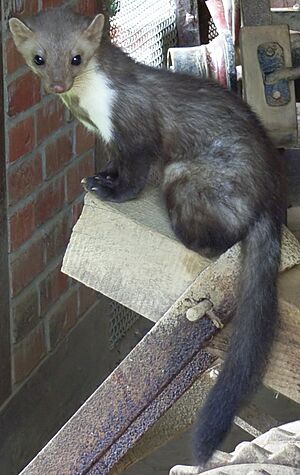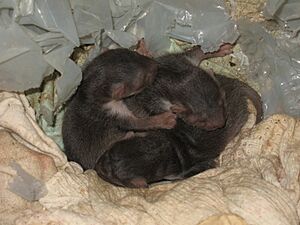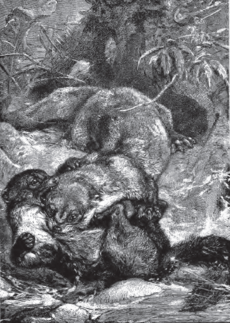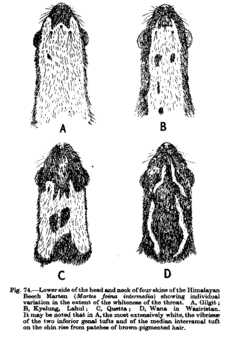Beech marten facts for kids
Quick facts for kids Beech marten |
|
|---|---|
 |
|
| Conservation status | |
| Scientific classification | |
| Genus: |
Martes
|
| Species: |
foina
|
 |
|
| Beech marten range | |
The beech marten (Martes foina), also known as the stone marten or house marten, is a type of marten. It lives in many parts of Europe and Central Asia. There's also a group of them living wild in North America. This animal is listed as "Least Concern" by the IUCN Red List. This means it's not in danger because it lives in many places, has a large population, and lives in protected areas. The beech marten looks a lot like the European pine marten. However, it's a bit smaller and prefers different places to live. Pine martens usually live in forests, but beech martens can live in many different open areas and forests.
Contents
About the Beech Marten's History
The beech marten likely came from an older animal called Martes vetus. This ancestor also led to the pine marten. The first fossils of M. vetus were found in places like Lebanon and Israel. Scientists think the beech marten first appeared in the Near East or southwestern Asia. It probably came to Europe later, during the Late Pleistocene or early Holocene periods.
Over time, the beech marten's skull changed. It became better at eating meat, with a smaller head and a shorter snout. This helped it have a stronger bite. These changes probably helped male beech martens avoid competing for food with females and with pine martens.
There are different types of beech martens, like the European beech marten and the Middle Asian beech marten. They can look a bit different depending on where they live.
What the Beech Marten Looks Like
The beech marten looks similar to the pine marten. But it has a slightly longer tail and a more pointed head. Its ears are shorter, rounder, and set wider apart. The beech marten's nose is usually a light peach or grey color. The pine marten's nose is dark black or greyish-black.
Its feet are not as furry as the pine marten's. This means you can see its paw pads even in winter. Beech martens move differently too. They tend to creep along like a European polecat, while pine martens jump and bound. Beech martens are not good in deep snow because their feet sink more easily.
Male beech martens are usually bigger than females. Males are about 43 to 59 centimeters (17 to 23 inches) long, not including the tail. Females are about 38 to 47 centimeters (15 to 18.5 inches) long. Their tails are about 25 to 32 centimeters (10 to 12.5 inches) long for males and 23 to 27.5 centimeters (9 to 11 inches) for females. Males weigh around 1.7 to 2.1 kilograms (3.7 to 4.6 pounds). Females weigh about 1.1 to 1.5 kilograms (2.4 to 3.3 pounds).
The beech marten's fur is rougher than the pine marten's. Its summer fur is short and thin. Its underfur, the soft fur underneath, is whitish, not grey like the pine marten's. The tail is dark brown. A key feature is its throat patch, which is always white. This patch is usually large and has two parts that reach back towards its front legs.
How Beech Martens Live


Beech martens are mostly active during twilight (dawn and dusk) and at night. They are especially active when the moon is out. They spend more time on the ground than pine martens. While they can climb well in forests, they are not as much of a tree-dweller. They are also good swimmers. Sometimes, they might be active during the day, especially in summer when nights are short. They usually hunt on the ground. In heavy snow, they might use paths made by hares or skiers.
Home and Territory
In some areas, a beech marten might have a home range of about 52.5 hectares (130 acres). They are most active between 6 PM and midnight. From 9 AM to 6 PM, they are usually resting. In cities, beech martens often make their dens in buildings, especially in winter. They don't dig their own burrows. Instead, they use natural cracks in rocks, spaces between stones, or empty buildings. They might even live in tree holes up to 9 meters (30 feet) high.
Family Life
Beech martens usually mate in June or July. This can happen in the morning or on moonlit nights, either on the ground or on rooftops. The mother is pregnant for a long time, about 236 to 237 days in the wild. Baby martens, called kits, are born in late March or early April. A mother usually has 3 to 7 kits.
When they are born, the kits are blind. They start to see when they are about 30 to 36 days old. They drink their mother's milk for about 40 to 45 days. By early July, the young martens look just like the adults.
What They Eat
Beech martens eat a lot more plants than pine martens. They enjoy fruits like cherries, apples, pears, plums, tomatoes, grapes, and raspberries. They tend to eat more plant food in the winter. They also hunt small animals like rats, mice, and chickens. They eat small birds like sparrows, and sometimes larger birds like partridges. They like to raid bird nests, often killing the parent birds as well as the young. While they usually don't bother farm animals, some martens might become good at hunting chickens, even if there's plenty of other food around. Male martens often hunt larger live prey, while females eat smaller prey and dead animals more often.
Other Animals Around Them
Where beech martens and pine martens live in the same area, they usually don't compete for food. Pine martens eat more birds and rodents, while beech martens eat more fruits and insects. However, there has been one case where a pine marten killed a young beech marten. Beech martens have also been known to kill European polecats sometimes. Larger animals like red foxes, lynxes, golden eagles, and Eurasian eagle-owls might hunt adult beech martens. Young martens can be attacked by birds of prey and wildcats. Interestingly, there was one report in Germany of a beech marten killing a domestic cat.
Where Beech Martens Live
The beech marten is found in many places across Europe and Central Asia. They live from Spain and Portugal in the west, through Central and Southern Europe, the Middle East, and Central Asia. Their range extends as far east as the Altai and Tien Shan mountains and northwest China.
They are not found in the British Isles, Scandinavian peninsula, Finland, or northern European Russia. They also live in Afghanistan, Pakistan, India, Nepal, Bhutan, and recently, they were confirmed to live in northern Burma.
Beech Martens in North America
Beech martens are also found in Wisconsin, USA, especially near cities like Milwaukee. They are also in some wooded areas in the Kettle Moraine State Forest and nearby woodlands. These North American beech martens likely came from animals that escaped a private fur farm in Burlington in the 1940s. Some were also reported to have escaped or been released in 1972.
Beech Martens and People
Can They Be Tamed?
Some scientists in the past thought that the "domestic cat" of Ancient Greeks and Romans might have actually been the beech marten. A famous marine biologist, Jeanne Villepreux-Power, even kept two tame beech martens.
Hunting and Fur
Even though the beech marten's fur is used in the fur trade, it's not as good quality as the fur from a pine marten. In the past, beech marten furs were a smaller part of the fur market compared to pine martens. Hunters mostly caught them in certain areas like the Caucasus and parts of Ukraine and Central Asia. Since other valuable fur animals are rare in those places, the beech marten is still important for local hunters. They are usually caught using traps. Shooting them is not very effective.
Car Damage
Since the 1970s, beech martens have sometimes caused damage to cars. They might chew on tubes and cables. Scientists aren't completely sure why they do this, as they don't eat the damaged parts. However, there are more car attacks in spring. This is when young martens are exploring their surroundings more and learning what they can and cannot eat.
Large Hadron Collider Incident
In 2016, two different beech martens caused a big surprise! They climbed onto electrical transformers near the Large Hadron Collider, which is the world's most powerful particle accelerator. This caused the collider to shut down twice. The second marten was later preserved and put on display in a museum.
|





